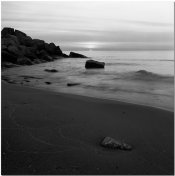If the sun is not in the frame and you want to catch the beauty of the sky at sunset you just meter the scene directly and the scene will be rendered correctly. That means that everything which is not the sky will be rendered as a silhouette and you can exploit this if the shape is recognisable (a tree, a cactus, a windmill etc).
An example by yours truly, metering the sky "as-is":
http://fineartamerica.com/featured/twilight-behind-the-vatican-fabrizio-ruggeri.html
One more question that keeps bugging me is when i use reflective metering, when should i compensate? I know for very dark or bright scenes i compensate but how dark is dark and how bright is bright. Take for example if my kids are playing in a beach and sun is going down, obviously they will all be quite dark looking because of the shadows etc. Now if i point the meter at them do i need to underexpose my shot or else they would be overexpose? Because as i understand the meter will average an 18% grey which means they will look brighter than they should therefore i should compensate. Am i correct? Or is this particular scene example not dark enough?
You should first ask us where the sun is in relation to your kids. If the sun is behind them, as it seems as you mean your kids would be "dark looking", well, you should move the sun in front of the kids* for decent results unless you are thinking about special effect (sun behind making the hair "glow" but then you should probably "fill" with flash etc.).
If for any reason (such as strong sun and you don't want them to "squint") you wanted to take a picture of the kids with the sun behind them, then you could do the following:
- "Tabular exposure": with 100 ISO shade is EV 12. You cannot go much wrong if the sun is still around 20° above the horizon;
- Use of reflected light meter: meter the palm of your hand in the same shade of your kids' face, and open 1 stop.
- (best) Measure of incident light. You don't need to go near your children, there are no trees on a beach, you just turn yourself and measure incident light at your kids' face height (to keep account of light reflected by the sand) and that's the measure.
The ordinary considerations apply regarding negative film to be so forgiving that tabular exposure would most probably work very well.
* It is probably easier if you rotate the kids and place yourself between kids and sun.







